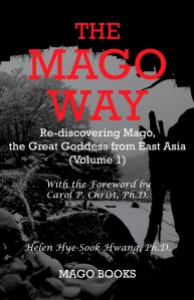You may purchase printed books at Mago Bookstore.
 The Mago Way: Re-discovering Mago, the Great Goddess from East Asia (Volume 1)
The Mago Way: Re-discovering Mago, the Great Goddess from East Asia (Volume 1)
Author: Helen Hye-Sook Hwang, Ph.D. With Foreword by Carol P. Christ
Description: In The Mago Way: Re-discovering Mago, the Great Goddess from East Asia, I have shared my personal, scholarly, and spiritual discoveries concerning the Great Goddess known as Mago in East Asia. Comprising eight essays researched, some published, between 2000 and 2015, this book is a crystallization of my feminist intellectual/spiritual/activist endeavor (1) to search for my own East Asian/Korean gynocentric cultural and historical background; (2) to dis-cover the overall features of Magoism, the mytho-historical-thealogical matrix that venerates Mago as the supreme divine; (3) to reinstate the pre- and proto-patriarchal mytho-history of Magoism from the perspective of Old Korea; (4) to assess cross-cultural parallels with worldwide Goddess traditions; and (5) to delineate the metamorphic nature of the Magoist Cosmogony. Due to the complexity of the Magoist Cosmogony, however, Volume 1 can only treat the first part, which is prior to the self-evolution of Mago Stronghold (Earth).
Eliciting the Reality of the whole, the Magoist Cosmogony tells us that HER Beginning is not a thing of the bygone past but the Work of WE/HERE/NOW. The ultimate agent, time, and space are the unified One. It informs us that the natural process of autogenesis takes place as the universe reaches HER sonic equilibrium. All things are self-born through the sonic movement of the universe. Mago too has come into being through the very music of Eight Tones, also known as “the music of the spheres” in the West.
Surviving unbridled by patriarchal censorship over the course of time, the Mago Cosmogony redefines the Holy Text as necessarily gynocentric. It awakens a deep knowing in us. It may be called a vision in that it is about dis-covering truth, to be precise, the gynocentric nature of Reality. The symbol of the Female (S/HE) is not a sex indicator. Encompassing the All, the Female is the Way of the Universe. I intend to use “sex” in place of “gender” in this book. First of all, the context (the Divine Realm of the Great Goddess) is prior to the bifurcation of the sexes. Thus, the notion of gender for “the Female” is irrelevant. Secondly, it is to restore the discussion of “sex” in place of “gender” for feminist discourse. “Sex” is the original factor that precedes and gives rise to the notion of “gender.” It is the biological nature of women and men that Magoist Feminism concerns, as it seeks the empowerment of “the female” rather than “the feminine” and the balance between “sexes” rather than “genders” across time and space.
Table of Contents:
| Acknowledgments | iv |
| Table of Figures | vii |
| Foreword by Carol P. Christ, Ph.D. | ix |
| Introduction | 1 |
| First Passage: The Personal Is Political and Cosmic | 7 |
| Chapter One: What Is Mago and Magoism and How I Did Study HER? | 8 |
| Chapter Two: Returning Home with Mago, the Great Goddess from East Asia | 31 |
| Chapter Three: A Cross-Cultural Feminist Alchemy: Studying Mago, Pan-East Asian Great Goddess, Using Mary Daly’s Radical Feminism as Springboard | 52 |
| Second Passage: Magoism and Old Korea | 60 |
| Chapter Four: Issues in Studying Mago, the Great Goddess of East Asia: Primary Sources, Gynocentric History, and Old Korea | 61 |
| Chapter Five: Making the Gynocentric Case: Mago, the Great Goddess of East Asia, and HER Tradition Magoism | 100 |
| Third Passage: The Metamorphic Creatrix | 122 |
| Chapter Six: Female Principle in the Magoist Cosmogony | 123 |
| Chapter Seven: Magos, Muses, and Matrikas: The Magoist Cosmogony and Gynocentric Unity | 149 |
| Chapter Eight: The Consciousness of WE/HERE/NOW in the Magoist Cosmogony | 171 |
| Glossary | 192 |
| Bibliography | 207 |